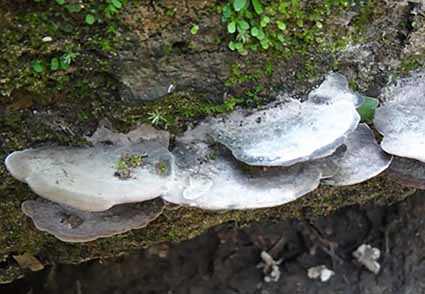Abstract
The present study deals with the descriptions of two Hirschioporaceae taxa from West Bengal, India, using morphological and molecular phylogenetic analyses of nrITS sequence data. Of these two taxa, Nigrohirschioporus violacaeruleum is newly described, while Pallidohirschiorus brastagii is a new record to West Bengal, India. Nigrohirschioporus violacaeruleum is characterized by a dimidiate, applanate, woody basidiocarp; a velutinate to glabrous, azonate upper surface coloured white to greyish violet; circular to angular pores (7–10 per mm) coloured lilac grey; dimorphic cystidia and inamyloid, ellipsoid to elongate basidiospores (3.5–6 × 2.5−3.0 µm). Pallidohirschioporus brastagii possess a sessile imbricate, pileate basidiocarp, an adpressed hispid, brownish orange concentrically zonate upper surface; a poroid to irpicoid hymenophore, apically encrusted, thick-walled cystidia, and inamyloid, cylindrical basidiospores (3‒5.5 × 1.5‒2.5 µm). Full descriptions, field photographs of the fruiting bodies, detailed morphological descriptions, and a molecular sequence-based phylogenetic tree, are provided.
References
- Darriba, D., Taboada, G.L., Doallo, R. & Posada, D. (2012) jModelTest 2: more models, new heuristics and parallel computing. Nature Methods 9: 772. https://doi.org/10.1038/nmeth.2109
- Dutta, A.K., Chandra, S., Pradhan, P. & Acharya, K. (2014) A new species of Marasmius sect. Sicci from India. Mycotaxon 128: 117–125. https://doi.org/10.5248/128.117
- Geyer, C.J. (1991) Markov chain Monte Carlo maximum likelihood. In: Keramidas, E.M. (ed.) Computing science and statistics; Proceedings of the 23rd Symposium on the interface: Seattle, Washington, Interface Foundation of North America, Fairfax Station, 156–163 pp.
- Gibertoni, T.B., Drechsler-Santos, E.R., Baltazar, J.M., Gomes-Silva, A.C., Nogueira-Melo, G.S., Ryvarden, L. & Cavalcanti, M.A.Q. (2011) The genus Trichaptum (Agaricomycetes, Basidiomycota) in Brazil. Nova Hedwigia 93: 85–96. https://doi.org/10.1127/0029-5035/2011/0093-0085
- Hall, T.A. (1999) BioEdit: a user-friendly biological sequence alignment editor and analysis program for Windows 95/98/NT. Nucleic Acids Symposium Series 41: 95–98.
- Hattori, T. (2005) Type studies of the polypores described by E.J.H. Corner from Asia and West Pacific Areas. VII. Species described in Trametes (1). Mycoscience 46 (5): 303–312. https://doi.org/10.1007/S10267-005-0250-Z
- Katoh, K., Misawa, K., Kuma, K. & Miyata, T. (2002) MAFFT: a novel method for rapid multiple sequence alignment based on fast Fourier transform. Nucleic Acids Research 30: 3059–3066. https://doi.org/10.1093/nar/gkf436
- Kornerup, A. & Wanscher, J.H. (1978) Methuen handbook of colour. 3rd ed; UK: London, Eyre Methuen Ltd.
- Kossmann, T., Costa-Rezende, D.H., Góes-Neto, A. & Drechsler-Santos, E.R. (2021) A new and threatened species of Trichaptum (Basidiomycota, Hymenochaetales) from urban mangroves of Santa Catarina Island, Southern Brazil. Phytotaxa 482 (2): 197–207. https://doi.org/10.11646/phytotaxa.482.2.8
- Kumar, S., Stecher, G. & Tamura, K. (2016) MEGA7: molecular evolutionary genetics analysis ver. 7.0 for bigger datasets. Molecular Biology and Evolution 33: 1870–1874. https://doi.org/10.1093/molbev/msw054
- Miller, M.A., Pfeiffer, W. & Schwartz, T. (2010) Creating the CIPRES science gateway for inference of large phylogenetic trees. In: Proceedings of the gateway computing environments workshop (GCE). LA: New Orleans, IEEE, pp. 1–8. https://doi.org/10.1109/GCE.2010.5676129
- Pradhan, P., Dutta, A.K. & Acharya, K. (2015) A low-cost long-term preservation of macromycetes for fungarium. Protocol Exchange. https://doi.org/10.1038/protex.2015.026
- Ronquist, F., Teslenko, M., Mark, P.V.D., Ayres, D.L., Darling, A., Höhna, S., Larget, B., Liu, L., Suchard, M.A. & Huelsenbeck, J.P. (2012) MrBayes 3.2: efficient Bayesian phylogenetic inference and model choice across a large model space. Systematic Biology 61 (3): 539–542. https://doi.org/10.1093/sysbio/sys029
- Ryvarden, L. & Gilbertson, R.L. (1994) European polypores. Part 2. Synopsis Fungorum 7: 394–743.
- Saha, R., Dutta, A.K. & Acharya, K. (2022) Murinicarpus subadustus: a new record from India, its morphology and phylogeny. Czech Mycology 74 (1): 103–109. https://doi.org/10.33585/cmy.74108
- Saha, R., Sett, S., Chatterjee, T., Basak, G., Roy, A. & Acharya, K. (2019) Contribution to the Macromycetes of West Bengal, India: 57–62. Research Journal of Pharmacy and Technology 12 (12): 5911–5916. https://doi.org/10.5958/0974-360X.2019.01025.4
- Sharma, J.R. (2012) Aphylloporales of Himalaya (Auriscalpiaceae—Tremellodendropsis). Kolkata: Botanical Survey of India, 590 pp.
- Stamatakis, A. (2006) RAxML-VI-HPC: maximum likelihood-based phylogenetic analyses with thousands of taxa and mixed models. Bioinformatics 22: 2688–2690. https://doi.org/10.1093/bioinformatics/btl446
- Vlasák, J. & Vlasák, J. Jr. (2017) Trichaptum (Basidiomycota) in tropical America: a sequence study. Mycosphere 8 (6): 1217–1227. https://doi.org/10.5943/mycosphere/8/6/8
- White, T.J., Bruns, T., Lee, S. & Taylor, J. (1990) Amplification and direct sequencing of fungal ribosomal RNA genes for phylogenetics. In: Innis, M.A., Gelfand, D.H., Sninsky, J.J. & White, T.J. (eds.) PCR protocols: A guide to methods and applications. San Diego, Academic Press, pp. 315–322. https://doi.org/10.1016/B978-0-12-372180-8.50042-1
- Zhou, M., Dai, Y.C., Vlasák, J., Liu, H.G. & Yuan, Y. (2023) Revision and updated systematics of Trichaptum s.l. (Hymenochaetales, Basidiomycota). Mycosphere 14 (1): 815–917. https://doi.org/10.5943/mycosphere/14/1/11


